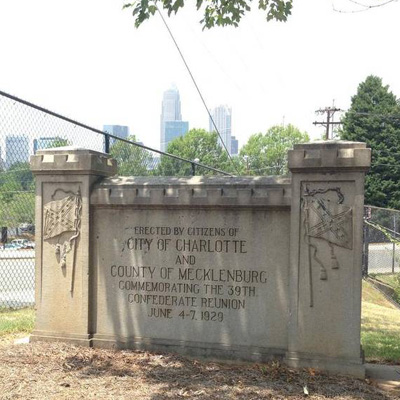
1929 Confederate Reunion Marker, Charlotte
A rectangular granite marker commemorates the 39th Confederate Reunion.
The inscribed horizontal stone is flanked by slightly higher vertical slabs. Confederate flags are embossed on both of them, on front and back.
The memorial
includes a time capsule holding the minutes of the 1929 reunion.
Images: Back of the memorial
Front:
ERECTED BY CITIZENS OF /
CITY OF CHARLOTTE /
AND /
COUNTY OF MECKLENBURG /
COMMEMORATING THE 39TH /
CONFEDERATE REUNION /
JUNE 4- 7, 1929
Back:
- GLORIA VICTIS - /
"IN COMMEMORATION OF THE 39TH. ANNUAL REUNION OF /
THE UNITED CONFEDERATE VETERANS AT CHARLOTTE, /
NORTH CAROLINA, JUNE 4-7, 1929./
A STATE AND CITY'S TRIBUTE OF LOVE; IN GRATEFUL /
RECOGNITION OF THE SERVICES OF THE CONFEDERATE /
SOLDIERS WHOSE HEROISM IN WAR AND FIDELITY IN /
PEACE HAVE NEVER BEEN SURPASSED /
ACCEPTING THE ARBITRAMENT OF THE WAR, THE PRESERVED /
THE ANGLO-SAXON CIVILIZATION OF THE SOUTH AND /
BECAME MASTER BUILDERS IN A RE-UNITED COUNTRY /
- VERITAS VINCIT -
June 7, 1929
35.218550 , -80.829630
View in Geobrowse
"2 Confederate memorials defaced in Charlotte," Charlotte Observer (Charlotte, NC), July 15, 2015
"Charlotte’s Confederate monument stirred passions, then and now," Charlotte Observer (Charlotte, NC), July 17, 2015 Link
"Confederate veterans reunion", Filmed on June 7, 1929. Sound documentary, Fox Movietone News Story 2-903 Link
"Defaced Charlotte Confederate memorials will be cleaned, returned to sites," Charlotte Observer (Charlotte, NC), July 16, 2015
"Defaced memorial stirred controversy from beginning," Charlotte Observer (Charlotte, NC), July 24, 2015
"Official program United Confederate Veterans, at their 39th reunion, held at Charlotte, N.C., June 5th, 1929." Link
"Unveil Marker for Veterans," Charlotte Observer (Charlotte, NC), June 8, 1929
De La Canal, Nick. "Confederate Marker Removed from Charlotte’s Grady Cole Center,” WFAE 90.7, WFAE.org, July 10, 2020, (accessed July 22, 2020) Link
Michael C. Hardy. Civil War Charlotte: Last Capital of the Confederacy, Charleston: The History Press, 108
Yes
Granite
The planning committee for the monument consisted of: Richard B. Stitt (chair), Dr. Addison Brenzer, H. Grady Moore, J.A. Daly, and Leardy Adams. Funds were raised by donations.
Dr. Albert Sidney Johnson was the presiding officer. While the Fort Bragg Military band provided music, Dr. E. N. Orr, provided the invocation. The main address was given by Dr. Oren Moore. The monument was unveiled by great grandson of Stonewall Jackson and granddaughter of William Morrison Stitt. Former Mayor Redd, who introduced Moore, proclaimed the monument demonstrated reunion had occurred in America. A copy of the records of the reunion and list of attendees was sealed inside the monument. The oldest living veteran present was tasked with placing the records in the monument. The Rev. John Long Jackson gave the benediction. The ceremony was reportedly filmed by Pathe News. A marine corp bugler, Arthur S. Whitcomb played taps at the end.
The monument was presented publicly on June 7, 1929 – a day before the 68th anniversary of North Carolina’s 1861 secession from the Union.
Mecklenburg native Richard Battle Stitt raised the money to produce the memorial. Stitt’s father, William Morrison Stitt, served in the Confederate Army and had been wounded at the Battle of Chancellorsville in May 1863.
Following the massacre of nine African Americans in a church in Charleston, South Carolina on June 17, 2015 by white supremacist Dylann Roof, Americans, especially southerners, have reflected on and argued over the historical legacy of slavery, the Civil War, the Confederacy, and white supremacy. Monuments have been a particular focus of these debates and controversies, especially after the death of a counter-protester, Heather Heyer, at a white supremacist rally in Charlottesville, Virginia in August 2017 and after President Donald Trump expressed his opposition to the removal of Confederate memorials. Despite laws in many southern states intended to prevent or impede the removal or relocation of historical monuments, protesters and local community leaders have removed or relocated controversial monuments associated with slavery, the Confederacy, and white supremacy. The pace of the removal of controversial monuments accelerated sharply in 2020, following the death of George Floyd at the hands of police in Minneapolis, Minnesota. Against the backdrop of protests against police brutality and white supremacy across the nation, local authorities in many communities in North Carolina removed and/or relocated monuments that were the focus of civil unrest.
The marker had been defaced with cement and was spray-painted in summer 2015 after the Charleston, South Carolina massacre.
Following both incidents, the county paid to have the monument cleaned, and county commissioners discussed the possibility of removing the marker, or adding a plaque with historical context. Neither effort was realized. Instead, the county installed a Plexiglas shield around the marker to protect it from future vandalism.
On June 21, 2020, Mecklenburg County Commission Chair, George Dunlap, directed the county manager to remove the marker after learning of threats to damage or deface it. The order was not carried out until on or about July 10, 2020.
In July 2020 the marker was placed in storage at an undisclosed location by Mecklenburg County.
Until July 2020, the marker stood right by a tall wire fence under shady trees on North Kings Drive, Charlotte, NC.
The memorial was located on North Kings Drive, on a hill next to Grady Cole Center and American Legion Memorial Stadium. It was on city property until Mecklenburg County’s park and recreation department merged with the city’s in 1991.
 Know anything else about this monument that isn't mentioned here? If you have additional information on
this or any other monument in our collection fill out the form at the Contact Us link in the footer. Thank you.
Know anything else about this monument that isn't mentioned here? If you have additional information on
this or any other monument in our collection fill out the form at the Contact Us link in the footer. Thank you.

